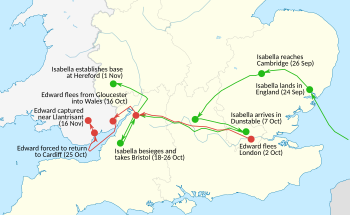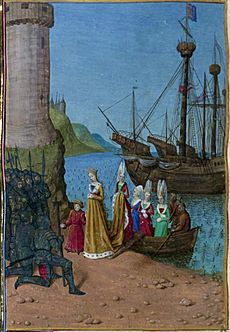Invasion of England (1326) facts for kids
Quick facts for kids Isabella and Mortimer's campaign |
|||||||
|---|---|---|---|---|---|---|---|
 Isabella's Campaign (green) and the Royalist retreat (brown) |
|||||||
|
|||||||
| Belligerents | |||||||
|
Supported by: County of Hainaut |
|||||||
| Commanders and leaders | |||||||
| Edward II (POW) Hugh Despenser the Younger Hugh Despenser the Elder Earl of Arundel |
Isabella of France Roger Mortimer Earl of Leicester Earl of Norfolk Earl of Kent |
||||||
| Strength | |||||||
| Unknown | 1,500 (invasion) | ||||||
| Casualties and losses | |||||||
| Unknown | Unknown | ||||||
The invasion of England in 1326 was led by Isabella of France, the queen of England, and her close ally, Roger Mortimer. This event led to big changes in England.
It resulted in the capture and execution of two powerful figures, Hugh Despenser the Younger and Hugh Despenser the Elder. It also caused Isabella's husband, King Edward II, to give up his throne. This invasion brought an end to a period of unrest and civil war in England.
Contents
Why the Invasion Happened
Roger Mortimer's Story
Roger Mortimer was a very powerful lord in England. He was married to a wealthy heiress named Joan de Geneville and had many children. In 1322, King Edward II captured Mortimer and put him in the Tower of London.
Mortimer's uncle died in prison, but Mortimer himself managed to escape in 1323. He made a hole in his cell wall, got onto the roof, and used rope ladders to get down to the River Thames. He then crossed the river and eventually reached safety in France.
Isabella and Mortimer's Alliance
In 1325, Prince Edward, who was the heir to the English throne, traveled to France. He went to pay respect to Charles IV of France, as was the custom for his lands in France. Isabella, Prince Edward's mother, went with her son.
During this trip, Isabella met Roger Mortimer again in Paris. They became very close allies. They both had a common enemy: King Edward II and his powerful favorites, the Despensers.
Isabella was told to return to England, but she refused in January 1326. She said she would only come back if Hugh Despenser was sent away from court. King Edward refused this demand. He then ordered Charles IV to make Isabella return, but Charles also refused. Edward then stopped sending money to Isabella.
Without support from France, Isabella and Mortimer left Paris in the summer of 1326. They took Prince Edward with them and traveled to William I, Count of Hainaut. Isabella arranged for Prince Edward to marry William's daughter, Philippa. In return, William gave Isabella a lot of money.
Isabella used this money to gather an army of soldiers. She also got ships from William to help with the invasion. Edward in England began to fear an invasion. Isabella kept her plans secret and even made a deal with the Scots to help her.
The Invasion Begins
Isabella's forces landed in England on September 24, 1326. After a brief moment of confusion about where they were, Isabella quickly moved inland. She was dressed in simple clothes. Many important people immediately joined her, including the bishops of Lincoln and Hereford.
Local soldiers, who were supposed to stop them, quickly switched sides. People who had suffered because of the Despensers also joined Isabella's cause. By the next day, Isabella was in Bury St Edmunds, and soon after, she reached Cambridge. Important nobles like Thomas, Earl of Norfolk, and Henry, Earl of Leicester, joined Isabella's army. On September 26, Isabella entered Cambridge.

By September 27, King Edward and the Despensers in London heard about the invasion. Edward ordered local officials to fight against Isabella and Mortimer. However, he had little trust that they would obey, as many disliked the Despensers. London itself became unsafe due to public anger, so Edward planned to leave.
Isabella moved west again, reaching Oxford on October 2. She was welcomed as a hero. The bishop of Hereford, Adam Orleton, came out of hiding to speak about how bad the Despensers were. Edward fled London on the same day, heading west towards Wales. Isabella and Mortimer now had a strong alliance with all of Edward's opponents.
Isabella then marched south towards London, stopping at Dunstable on October 7. London was now controlled by angry crowds, who generally supported Isabella. A bishop named Walter de Stapledon tried to protect his property from rioters. He was disliked by the people and was attacked and killed. His head was later sent to Isabella by her supporters.
Meanwhile, Edward was still fleeing west, reaching Gloucester by October 9. Isabella quickly marched west herself to try and cut him off. She reached Gloucester a week after Edward, who managed to slip across the border into Wales on the same day. Isabella was joined by powerful northern lords, giving her complete military control.

Hugh Despenser the Elder tried to hold the city of Bristol against Isabella and Mortimer. They put Bristol under siege from October 18 until October 26, when it fell. Isabella was able to get her daughters, Eleanor of Woodstock and Joan of the Tower, back from the Despensers' care.
Edward and Hugh Despenser the Younger were desperate. Many of their supporters had left them. They tried to sail to Lundy, a small island, but bad weather forced them back to Wales.
With Bristol secured, Isabella moved her main base to Hereford. From there, she ordered Henry of Lancaster to find and arrest her husband. After two weeks of trying to avoid Isabella's forces in South Wales, Edward and Hugh were finally caught near Llantrisant on November 16. This capture brought an end to the rebellion and the civil war.
What Happened Next
Edward II died, likely killed under mysterious circumstances. Hugh Despenser the Younger and Edmund Fitzalan were both executed in a very harsh way. The deaths of these powerful figures, along with Edward II, ended the civil war. It also led to a year of looting the Despensers' properties and many people being pardoned.
On March 31, 1327, Edward III, following Isabella's instructions, made a peace treaty with Charles IV of France. This treaty returned some lands to Edward, but France received money and other territories. This left the young King Edward with less land in France.


